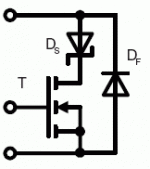I got some BYV79E. In the datasheet, it has rating of If=14A, Ifrm=28A, Isfm=150A. Which rating is usefull if I wanted to put this dioda for Ds and Df (picture below) for making discrete anti-parrarel mosfet with IRFP260N (position T)?
I notice that some classD pro-amps uses dioda with current rating way below mosfet's current rating when making discrete anti-parrarel dioda.
Is it If or Ifrm or Isfm rating from a dioda's datasheet that is usefull for position Ds and Df?
I notice that some classD pro-amps uses dioda with current rating way below mosfet's current rating when making discrete anti-parrarel dioda.
Is it If or Ifrm or Isfm rating from a dioda's datasheet that is usefull for position Ds and Df?
Attachments
I got some BYV79E. In the datasheet, it has rating of If=14A, Ifrm=28A, Isfm=150A. Which rating is usefull if I wanted to put this dioda for Ds and Df (picture below) for making discrete anti-parrarel mosfet with IRFP260N (position T)?
I notice that some classD pro-amps uses dioda with current rating way below mosfet's current rating when making discrete anti-parrarel dioda.
Is it If or Ifrm or Isfm rating from a dioda's datasheet that is usefull for position Ds and Df?
David you are using a 200V slow mosfet whereas at same VDS IRF has some fast mosfets with much higher current ratings than this mosfet.
Lets block the body diodes of mosfets if your application is demanding operation above 250V
HINT: Current rating of schottky should be atleast the current you are passing thru load.
Hi, Workhorse,
This is the part that I'm not clear. Which current rating? If I look at one particular pro amp, mosfet T is rated at 80A, Ds is rated at 35A (If), Df is rated at 30A(If). Supply rail +/-180VDC, can work up to 2ohm load. Which current parameter of the dioda to look at? Seems (If) is not the one that is used during design stage.
This is the part that I'm not clear. Which current rating? If I look at one particular pro amp, mosfet T is rated at 80A, Ds is rated at 35A (If), Df is rated at 30A(If). Supply rail +/-180VDC, can work up to 2ohm load. Which current parameter of the dioda to look at? Seems (If) is not the one that is used during design stage.
In class D, peak, average and RMS currents through the switches are not the same as output current.
Also, a diode can usually handle more relative overload than a MOSFET, in part because MOSFET losses are Irms^2*R plus switching while diodes are mainly Iavg*Vf + Irms^2*Reff.
So both average current and maximum repetitive current ratings have to be considered for diode selection, and rms and pulse current for MOSFET selection.
In general the criteria is not to exceed repetitive peak ratings or average ratings and dissipate a reasonable amount of heat per device.
When body diodes are being used, there are additional di/dt, dv/dt and (mainly) peak Irr ratings not to exceed to avoid MOSFET latch up.
Also, a diode can usually handle more relative overload than a MOSFET, in part because MOSFET losses are Irms^2*R plus switching while diodes are mainly Iavg*Vf + Irms^2*Reff.
So both average current and maximum repetitive current ratings have to be considered for diode selection, and rms and pulse current for MOSFET selection.
In general the criteria is not to exceed repetitive peak ratings or average ratings and dissipate a reasonable amount of heat per device.
When body diodes are being used, there are additional di/dt, dv/dt and (mainly) peak Irr ratings not to exceed to avoid MOSFET latch up.
Hi, Workhorse,
This is the part that I'm not clear. Which current rating? If I look at one particular pro amp, mosfet T is rated at 80A, Ds is rated at 35A (If), Df is rated at 30A(If). Supply rail +/-180VDC, can work up to 2ohm load. Which current parameter of the dioda to look at? Seems (If) is not the one that is used during design stage.
Stop eyeing QSC PL380 schematic, do you know the rail drop in that amp is 50V when driving 2 ohm load on both channels. So your so called rail voltage of 180V drops to about 140V at 2 ohm loading.
In that way using a 35A [average continuos current]schottky is safer as long as music signal is concerned.
- Status
- This old topic is closed. If you want to reopen this topic, contact a moderator using the "Report Post" button.
